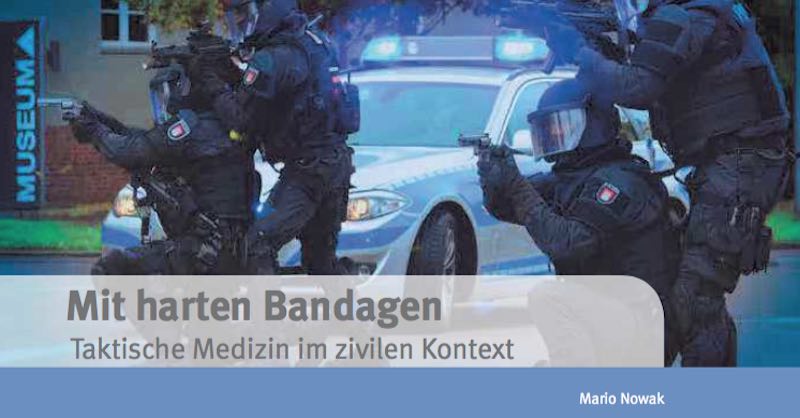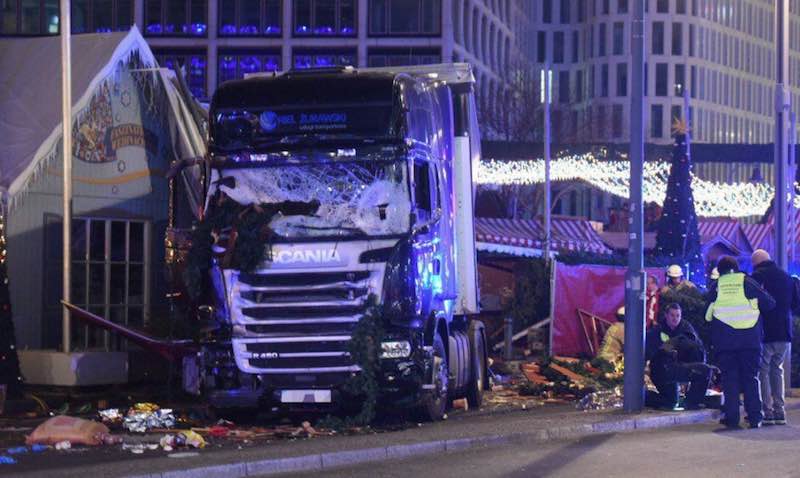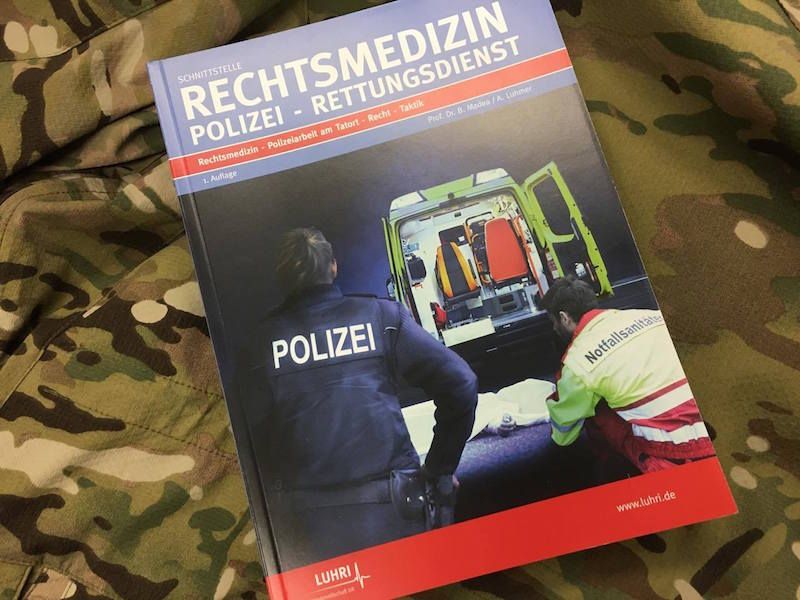Get the weekly SPARTANAT newsletter.
Your bonus: the free E-Book from SPARTANAT.

With tough bandages (1) - Tactical medicine in a civilian context
Tactical medicine is crucial in the face of increasing terrorist attacks, requiring quick and efficient care for the injured. Mario Nowak shares expert insights on life-saving techniques in his contribution "Mit harten Bandagen" within the book "Schnittstelle Rechtsmedizin". The article highlights the importance of tactical medicine in providing initial care in hostile environments and emphasizes the need for comprehensive training and equipment for emergency personnel facing modern threats.
Tactical medicine has nothing to do with military and war? Far from it. The quick and efficient initial care for the injured and wounded is not only a highly topical issue with the increasing number of terrorist attacks, but also for civilians. Mario Nowak comes from a law enforcement background and imparts specialized knowledge for life-saving with Tactical Survival Concepts. With the contribution "Mit harten Bandagen" (With Hard Bandages) he introduces TCCC in the specialist book "Schnittstelle Rechtsmedizin" (above the cover, see the source link at the end of the article). We at SPARTANAT are pleased to be able to present this excellent contribution to you as a five-part mini-series:
Tactical medicine is a craft
If you are expecting a scientific treatise in the following chapter, dear reader, then I must disappoint you right at the beginning. Tactical medicine does not meet scientific standards, but is primarily one thing: a rough, extremely unsentimental craft. The actors are primarily tactically trained users who also possess the manual skills that enable them to perform life-saving initial measures in a perpetrator-controlled, extremely hostile environment. I also consciously refrain from using a gender-politically "correct" choice of words. Exploding explosive vests, car bombs, and projectiles fired from automatic rifles do not distinguish between male and female police officers, between male and female paramedics, between male and female emergency physicians. And neither do I. The work environment of rescue personnel and police officers in Germany has become rougher. Never have the attacks on police officers and emergency service personnel been as high as they are today. As if that weren't alarming enough, Germany is now increasingly coming under the crosshairs of terrorist perpetrators. And this is a threat for which our authorities and organizations with security responsibilities (BOS) are collectively nowhere near prepared; neither in terms of personnel, nor in terms of equipment, let alone training. As I write these lines, various police operations against Islamist and right-wing extremists are being carried out nationwide on a weekly basis – and presumably a number of terrorist attacks are being prevented. Except for the tactical special units, the vast majority of our police officers lack a basic understanding of infantry for their own safety. This is absolutely essential for an effective fight against well-equipped violent perpetrators trained in terrorist warfare in the future. However, the "pressure" in Germany, unlike, for example, in our French and Belgian neighbors, does not seem to be great enough yet, so there is a lack of political will for "mental" escalation in this country. I intentionally use the term "war". Because on our streets, terrorists trained in war techniques are now using war weapons against citizens and guerrilla warfare tactics against police officers. This situation can only be adequately addressed if there is a rapid and radical change in thinking among decision-makers and users.
The work environment of rescue personnel and police officers in Germany has become rougher. Never have the attacks on police officers and emergency service personnel been as high as they are today. As if that weren't alarming enough, Germany is now increasingly coming under the crosshairs of terrorist perpetrators. And this is a threat for which our authorities and organizations with security responsibilities (BOS) are collectively nowhere near prepared; neither in terms of personnel, nor in terms of equipment, let alone training. As I write these lines, various police operations against Islamist and right-wing extremists are being carried out nationwide on a weekly basis – and presumably a number of terrorist attacks are being prevented. Except for the tactical special units, the vast majority of our police officers lack a basic understanding of infantry for their own safety. This is absolutely essential for an effective fight against well-equipped violent perpetrators trained in terrorist warfare in the future. However, the "pressure" in Germany, unlike, for example, in our French and Belgian neighbors, does not seem to be great enough yet, so there is a lack of political will for "mental" escalation in this country. I intentionally use the term "war". Because on our streets, terrorists trained in war techniques are now using war weapons against citizens and guerrilla warfare tactics against police officers. This situation can only be adequately addressed if there is a rapid and radical change in thinking among decision-makers and users.
Unilateral armament of police forces in the form of improved passive weaponry, i.e.: ballistic body armor, through the acquisition of protective vests or ballistic plate carriers that can withstand shots from high-caliber assault rifles to some extent, can only be a first step. Coupled with the expectation that the officers equipped in this way will confront and neutralize terrorists armed with war weapons and explosives, it is in the best case a gross violation of occupational safety regulations; in the worst case, it is dehumanizing. War weapons can only be countered with the use of war weapons in the long run. However, as long as German police officers are armed only with a pistol, even if it may be a submachine gun, they are merely ballistically upgraded cannon fodder. But apparently, assault rifles in the hands of police officers do not (yet) fit into our political worldview. Therefore, the topic of "tactical medicine" will be even more important in the future. After all, someone has to take care of the wounded officers who await us in this unequal fight.
When injury patterns resemble those on battlefields
Previously confronted mainly with internal medical emergencies and injuries due to traffic and household accidents, and prepared for them professionally, rescue personnel will increasingly have to deal with injury patterns that were mostly found on battlefields in the past. In terrorist attacks in Nice, France in July 2016 and at the Christmas market at Berlin's Breitscheidplatz in December 2016, the perpetrators intentionally drove trucks into crowds of people, killing dozens and seriously injuring hundreds. Terrorist organizations like the Islamic State (IS) call on potential attackers via the internet to use vehicles as weapons in carrying out their perfidious attack plans if they cannot obtain explosives or automatic firearms. In treating victims of the two aforementioned attacks, rescue personnel had to deal more with blunt injury mechanisms typical of traffic accidents. These present a relatively familiar sight to them, although the number of victims, which likely significantly overshadowed the "normal" mass casualties from accidents, such as those on highways, may have been far higher.
In terrorist attacks in Nice, France in July 2016 and at the Christmas market at Berlin's Breitscheidplatz in December 2016, the perpetrators intentionally drove trucks into crowds of people, killing dozens and seriously injuring hundreds. Terrorist organizations like the Islamic State (IS) call on potential attackers via the internet to use vehicles as weapons in carrying out their perfidious attack plans if they cannot obtain explosives or automatic firearms. In treating victims of the two aforementioned attacks, rescue personnel had to deal more with blunt injury mechanisms typical of traffic accidents. These present a relatively familiar sight to them, although the number of victims, which likely significantly overshadowed the "normal" mass casualties from accidents, such as those on highways, may have been far higher.
Vehicles, bombs, firearms, knives ...
So far, the use of vehicles as the primary weapon in terrorist attacks in Europe is the exception rather than the rule. Attacks like the coordinated assaults by Islamist extremists in Paris in November 2015 or the shooting at an Istanbul nightclub on New Year's Eve 2016 are examples of the "new" threat that our security and rescue forces will have to prepare for in the future. As these and countless similar cases of terrorist attacks and rampages make clear, the injury patterns mainly consist of penetrating traumas caused by firearms and blast traumas caused by USBVs (Unconventional Explosive and Incendiary Devices) in the form of pipe bombs, explosive vests or car bombs, and/or conventional explosive devices, e.g. hand grenades and mines. In the context of rampages and isolated attacks by individual extremists with limited logistics, injuries caused by melee and stabbing weapons are also included. Combined with a mass influx of such injured individuals and the need for immediate medical intervention in an unsecured work environment, it can be assumed that the vast majority of emergency service personnel would currently be overwhelmed by such a scenario.
Unarmed rescue personnel cannot be expected to operate in extreme danger in an unsecured environment. There first needs to be an immediate armed intervention to prevent the attackers from further actions and then establish a secure working environment for the care of the wounded. This task will generally fall to the police, as well as other armed security personnel present at the scene of the attack. Therefore, the principles of tactical medicine, originally developed for the military, have now been integrated into the police working environment. But tactical medicine also offers a wealth of behavior tips and suggestions for civilian rescue personnel and emergency physicians, whose adherence will significantly increase their personal safety during work in the event of an attack. The goal of this chapter is therefore to familiarize the reader with the basics of tactical medicine.
The series "Mit harten Bandagen" here on SPARTANAT:
Mit harten Bandagen (1): Tactical Medicine in a Civil Context
Mit harten Bandagen (2): Tactical Combat Casualty Care/Tactical Emergency Medical Support
Mit harten Bandagen (3): The Procedure
Mit harten Bandagen (4): The Three Tactical Phases
Mit harten Bandagen (5): Tactical First Aider
Tactical Survival Concepts on the Internet: http://tacsurv.de
The entire article by Mario Nowak is published in the book "Schnittstelle Rechtsmedizin: Polizei – Rettungsdienst". Available here:
SPARTANAT is the online magazine for Military News, Tactical Life, Gear & Reviews.
Send us your news: [email protected]
Ad
similar
Get the weekly SPARTANAT newsletter.
Your bonus: the free E-Book from SPARTANAT.


